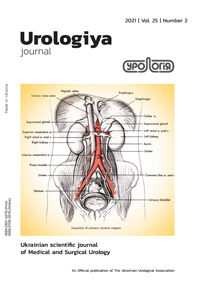Research of indicators of pro- and antioxidant system in spermoplasm in violation of fertility in men
DOI:
https://doi.org/10.26641/2307-5279.25.2.2021.238228Keywords:
male infertility, spermoplasm, oxidative stress, antioxidant systemsAbstract
The article presents the study results of marker indicators of pro- and antioxidant spermoplasm systems among men of reproductive age with various types of infertility. It is shown that patients who were diagnosed with “secretory male infertility”, had the level of MDA content that was exceeding control indicators in 1.2 times (aЈ0,05) with simultaneous activation of SOD (in 132.2%, aЈ0,05) against the background of slight CAT activity decreasing. The SOD/CAT ratio increased in 1.44 times compared to the control, and the activity of GAOS enzymes was not significantly different from the control group. The condition of pro- and antioxidant protection system can be classified as “activated” due to “SOD + CAT” link with imbalance in the system, which can lead to progression of cytotoxic effects.
The patients’ segmentation who were diagnosed with “excretory-toxic male infertility” into three subgroups by MDA content in spermoplasm made it possible to establish that the first subgroup was characterized by “compensatory activation” mainly of GAOS against the background of decreasing MDA content, in the second subgroup - indicators of the pro- and anti-radical protection system did not have reliable differences comparing with control results. The third subgroup showed increase of MDA content (66.1%, aЈ0,01) and activity decrease of all anti-radical protection systems. The state of pro- and antioxidant protection system in this subgroup can be classified as “oxidative stress.”
The indicators study of pro-antioxidant systems in spermoplasm among patients with various types of male infertility will allow to carry out pathogenetically justified prevention and correction of conditions, which are accompanied by development of oxidative stress.
References
Щорічна доповідь про стан здоров’я населення, санітарно-епідемічну ситуацію та результати діяльності системи охорони здоров’я України. Київ: МВЦ «Медінформ», 2018. 458 с.
Muratori M., Marchiani S., Tamburrino L., Baldi E. Sperm DNA Fragmentation: Mechanisms of Origin. Advances in Experimental Medicine and Biology. 2019. Vol. 1166. P. 75–85. Doi: 10.1007/978-3-030-21664-1_5.
Nouri M., Amani R., Nasr-Esfahani M., Javad-Tarrahi M. The effects of lycopene supplement on the spermatogram and seminal oxidative stress in infertile men: A randomized, double-blind, placebo-controlled clinical trial. Phytotherapy Research. 2019. No 33(12). P. 3203–3211. Doi: 10.1002/ptr.6493.
Поворознюк М.В. Стан репродуктивного здоров’я чоловіків у шлюбі. Медичні аспекти здоров’я чоловіка. 2019. № 4(35). С. 51–57.
Onul N., Biletska E., Stus V., Polion M. The role of lead in the ethiopathenesis of male fertility reduction. Wiadomsci Lekarskie. 2018. № 4. С. 1155–1160.
Фафула Р., Онуфрович О., Єфремова У., Воробець З. Характеристика глутатіонпероксидази сперматозоїдів інфертильних чоловіків. Науковий вісник Східноєвропейського національного університету ім. Лесі Українки. 2018. №8. С. 77–81.
Современные методы в биохимии / под ред. акад. В.Н. Ореховича. М.: «Медицина», 1971. 392 с.
Казимирко В.К., Мальцев В.И. Aнтиокси-дантная система и ее функционирование в организме человека. Здоровье Украины. 2004. Вып. 98. С. 40–45.
Королюк М.А., Иванова Л.И., Майорова И.Г., Токарев В.Е. Метод определения активности каталазы. Лабораторное дело. 1988. № 1. С. 16–19.
Справочник по лабораторным методам исследования / под ред. Л.А. Даниловой. СПб.: Питер, 2003. 736 с.
Антомонов М.Ю. Математическая обработка и анализ медико-биологических данных. Киев: Мединформ, 2018. 579 с.
Downloads
Published
Issue
Section
License
Стаття повинна мати візу керівника та офіційне направлення від установи, з якої виходить стаття (з круглою печаткою), і вказівкою, чи є стаття дисертаційною, а також у довільній формі на окремому аркуші - відомості про авторів (прізвище, ім’я, по батькові, посада, вчений ступінь, місце роботи, адреса, контактні телефони, E-mail).
Стаття повина бути підписана всіма авторами, які укладають з редакцією договір пропередачу авторських прав (заповнюється на кожного автора окремо з оригінальним підписом). За таких умов редакція має право на її публікацію та розміщення на сайті видавництва.

